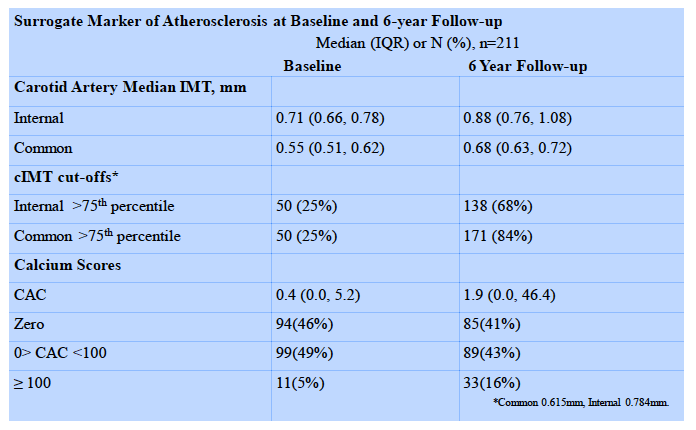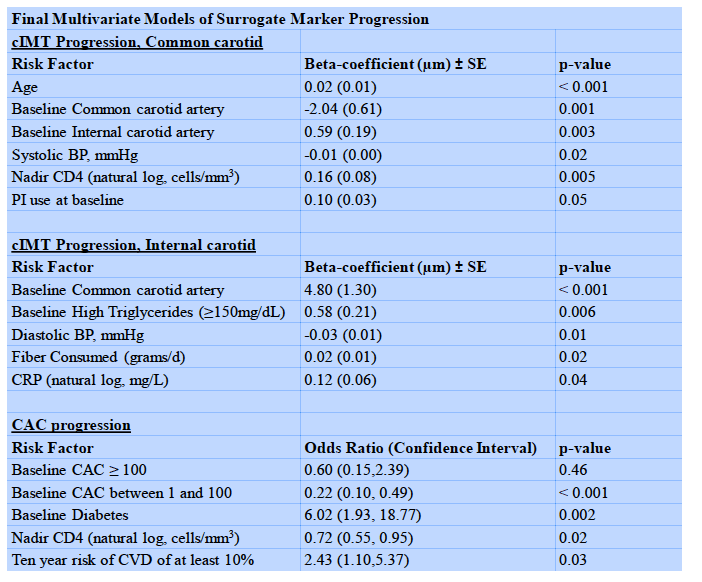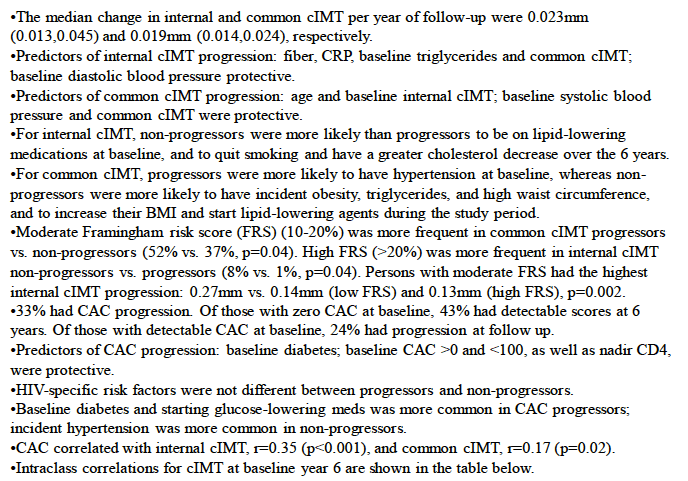 |
 |
 |
| |
Carotid artery intima-media thickness and coronary artery calcium progress in HIV-infected participants over 6 years of follow-up
|
| |
| |
Reported by Jules Levin
IAC 2012
Volpe G1,2, Skinner SC1, Tang A1, Mangili A1, Wanke CA1,2
1Nutrition Infection Unit, Tufts University School of Medicine, Boston, MA, 2Division of Geographic Medicine and Infectious Disease, Tufts Medical Center, Boston, MA
We evaluated predictors of CVD surrogate marker progression over 6 years in a cohort of 211 HIV-infected persons.

Abstract
Background: Surrogate markers of cardiovascular disease risk, including carotid intima-media thickness (cIMT) and coronary artery calcium (CAC), have been previously used in HIV-infected populations. We evaluated both progression of these surrogate markers and predictors of progression in a longitudinal cohort of HIV-infected adults over a 6-year period.
Methods: Common and internal cIMT, CAC scores, vascular and HIV risk factors were examined at baseline and at 6 years in 211 HIV-infected adults, 27% female and 49% non-white, whose mean age at start was 45 ± 7 years.
Results: The median change in common carotid artery and internal carotid artery over 6 years was 0.12mm (0.09,0.15) and 0.15mm (0.08,0.28), respectively. Over the study period, the 10-year Framingham risk score increased from 6.1% (3.6,10.8) to 8.6% (5.3,12.8) (p<0.001) and the percentage of participants with common cIMT ≥0.615mm and internal cIMT ≥0.784mm (75th percentile at baseline) increased from 25% to 84% (p=0.05) and from 25% to 68% (p=0.16), respectively. Age, baseline internal cIMT, and nadir CD4 predicted common cIMT progression, but baseline common cIMT and systolic blood pressure were protective. Predictors of internal cIMT progression were baseline common cIMT, baseline high triglycerides, C-reactive protein, and fiber intake, while higher baseline diastolic blood pressure was protective. At baseline, the percentage of participants with undetectable CAC and CAC ≥100 were 46% and 5%, respectively, and at 6 years were 41% and 16%, respectively. Predictors of CAC progression included diabetes, while baseline CAC between 0 and 100 as well as nadir CD4 were protective;
Conclusions: Overall, CAC and cIMT progressed over 6 years in this cohort of HIV-infected persons. Aggressive identification and management of risk factors may reduce progression in this population.
INTRODUCTION
· Cardiovascular disease (CVD) is a common and increasingly important problem in HIV-infected individuals as mortality from this infection decreases and infected individuals age.
· Surrogate markers of atherosclerosis, the precursor of CVD, have been applied to this population in order to assess cardiovascular risk before clinically apparent events occur; however, long-term studies of changes in CVD surrogate markers over time in this population have not been performed.
· Determining predictors of CVD surrogate marker progression in this population would facilitate targeted risk-reduction strategies and identify significant clinical endpoints for interventions.
· We evaluated predictors of CVD surrogate marker progression over 6 years in a cohort of 211 HIV-infected persons.
METHODS
Clinical information was collected from participants at baseline and every 12 months for 6 years thereafter. CVD surrogate markers were obtained at baseline and 6 years.
cIMT measurements were obtained via high-resolution B ultrasound images of the right and left common and internal carotid arteries. Ultrasound protocols were adapted from the Cardiovascular Health Study and performed by centrally trained and certified ultrasonographers. One longitudinal, lateral view of the distal 10mm of the common carotids and 3 longitudinal views of the internal carotids were used. The mean of the maximum of the near- and far-wall cIMT was the measure used for the final analysis.
CAC scores were obtained by ultrafast computed tomography scan of the heart with synchronized ECG to select images least affected by cardiac motion. Scores were computed using standardized scoring techniques.
Multivariate regression analysis was used to determine predictors of cIMT and CAC progression.
Statistical analyses were performed with SAS for Windows, Version 9.2; SAS Institute, Inc.






|
| |
|
 |
 |
|
|